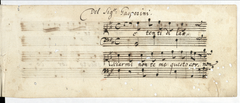Report on Electronic Data Delivery to RISM using the Moravská zemská knihovna v Brně (Moravian Library; CZ-Bu) as an example: Requirements, Procedure, and Description of the Collection
Guido Kraus
Thursday, November 22, 2018

Over the past two years, the RISM Central Office has received a number of electronic data deliveries from Italy, France, the United States, and the Czech Republic, with the Czech delivery containing “only” 2,078 catalog descriptions of music manuscripts. The data in the file from the Moravská zemská knihovna v Brně (Moravian Library, formerly the University Library; RISM siglum CZ-Bu) in Brno, Czech Republic were in MARC format, which made it easier for RISM to transfer them to Muscat, a MARC-based cataloging program. But the catalog records were entirely in Czech, and after randomly checking some of the fields, I determined that although the data were largely compatible and could basically be transferred from MARC field to MARC field, another solution had to be found to make work easier for the standardized terms used. First, I created a two-column concordance list (Czech/English) for the subject headings, which made it possible for our IT department to convert the Czech terms in the import file to the English terms used by RISM. A second concordance list had to do with standardized titles. Here, too, the Czech terms could be converted to English ones. With the help of a third list, Czech terms for the material types were translated into English. The next step was to import the revised data into the live Muscat system.
However, this did not mean that the imported data were ready for publication yet. The status of the records was set to “unpublished” by the RISM IT department. Each record had to be edited by me and further adapted to RISM guidelines, then set to “published” after completion of review. This adjustment to the RISM format later facilitates the readability of the records and searching for them in the RISM online catalog.
We also migrated the links to the records in the Brno online catalog to Muscat. CZ-Bu also linked to images of the music incipits and the old scanned index cards of the former Moravian University Library, which is now called the Moravian Library (see above). The scans of the old index cards contain music incipits and other information that go beyond the records in the Brno online catalog. Digital images of title pages were also linked to the records. We imported all these links; the scans, the images and the original Czech records aided me in editing the imported records in Muscat.
The music manuscript collection in CZ-Bu contains sources from the 18th century up to the present day. From the 20th century up to the 21st century there are a number of copies of works from the late 18th century that were copied by hand for private study and music making. Printed music editions typically served as the model for copying. In addition to music of international significance, the repertoire also includes works of national and regional importance. The most prolific composer is Mr. or Ms. Anonymous with 89 entries, followed by Franz Krommer with 76. Johann Baptist Vanhal is in third place with 57 records for sources. Wolfgang Amadeus Mozart is in eighth place with 38 entries. Osvald Chlubna brings up the rear with three works.
As already mentioned, there are only 89 anonymous sources in the collection. That is approximately 4.5% of the collection. This unusually low number can be explained by the selection of the works by the copyists, a thorough examination of the sources on site, and identifying the works by incipit comparison. My share of identifications is low and amounts to sixteen entries.
The portion of autograph manuscripts is relatively high with 284 sources. That is about 13.5% of the collection. Most autograph works are by Czech or Moravian composers, mainly Otto Zweig with 43 works, Karel Růžička with 32, and Gustav Bosanyi with 18 autographs.
Highlights of the collection include an autograph manuscript of a song from 1952 by Milan Kundera with the title “Píseň o loučení” (Farewell Song; RISM ID no. 553014479). There are individual sources from the 1920s for occasional music relating to the Workers’ Olympiads in Prague, such as Karel Krammel’s “Triumfální pochod Dělnické Olympiady 1921” (Triumphal March of the Workers’ Olympiad; RISM ID no. 553013169) and pieces for gymnastic routines such as František Stupka’s “Prostná cvičení dorostenek” (Simple Routines for Young Athletes) from 1946 (RISM ID no. 553013161). The oldest source dates back to 1696 and is a collection of 19 Italian arias for soprano and basso continuo. The vocal works are by Francesco Gasparini, Giovanni Bononcini, Giacomo A. Perti, and Luigi Mancia (RISM ID no. 553013031).
There is much more you can discover in the RISM catalog from this CZ-Bu import. It is a collection containing a great variety of sources and musical works that is not a closed unit but rather open in all directions, both chronologically and musically. I hope you enjoy exploring and wish you success in your work with these records.
Image: Árie italských mistrů ze 2. pol. 17. století pro soprán a basso continuo / Italian arias from the second half of the 17th century, p. 5. CZ-Bu RKPMus-0763.835; RISM ID No. 553013031. Available online.
Share Tweet EmailCategory: Library collections

